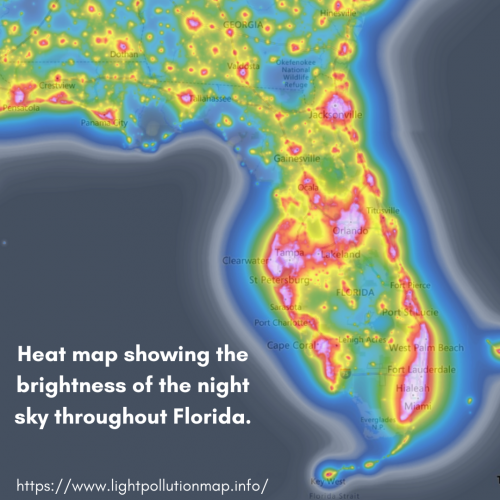When someone mentions the word pollution, most people think of increasing carbon emissions or plastic in the natural environment. But the pollution associated with an excessive amount of artificial light is also a prevalent problem that isn’t talked about as much. Light pollution can cause a multitude of problems from negatively impacting wildlife behavior to interfering with the health of human beings.
What’s going on?
Light pollution is the result of the excessive use of artificial outdoor light. Too much light is considered pollution because it can negatively impact the behavior of wildlife, human health, and the ability to see stars at night.
The problem of light pollution became widely known with the release of the World Atlas of Night Sky Brightness, a map that shows the brightness of the sky at night.

There are four main types of light pollution:
- Sky Glow : The brightness in the night sky caused by artificial lights over urban areas.
- Glare: Extreme brightness that can hurt your eyes, like seeing bright lights while driving.
- Clutter: Excessively bright and disorienting groups of light sources, like in Times Square.
- Light Trespass: Light that extends into areas where it is not needed or wanted.
Why it matters.
There are some places in Florida where you can view the unobstructed night sky, like the Dark Sky-certified Kissimmee Prairie Preserve State Park. However, the rest of the state, especially the highly populated areas, suffers from the effects of light pollution.
Skyglow light pollution that occurs over urban areas makes it extremely difficult for people to view more than a few stars in the night sky.
Excessive artificial light can repel some organisms away from their natural habitat, which could be considered a form of habitat loss. It can also attract them to areas where they should not be, which leads to a high concentration of animals that can be easily preyed on or killed by other means.
Light pollution also alters the day/night patterns of both humans and wildlife. This disturbance of natural rhythms can result in a lack of sleep, not having enough time for the body to repair itself, and interrupted reproductive cycles.
The wildlife that is most affected by light pollution are:
- Monarch Butterflies
- Tree Frogs
- Atlantic Salmon
- Fireflies
- Sea Turtles
While these animals are considered the most threatened by light pollution, the issue still affects a plethora of other organisms.
What you can do.
The best way to combat light pollution is to turn lights off at night. If that isn’t possible, use fully shielded, light-efficient fixtures that prevent light from reaching unwanted areas.
In addition to properly using outdoor lighting, limit the amount of light from inside your house leaking out by closing window blinds and curtains at night to keep it inside.
Information from National Geographic, Florida State Parks, Fish and Wildlife Conservation Commission, James Madison University, the International Dark Sky Association, and the World Atlas of Night Sky Brightness.